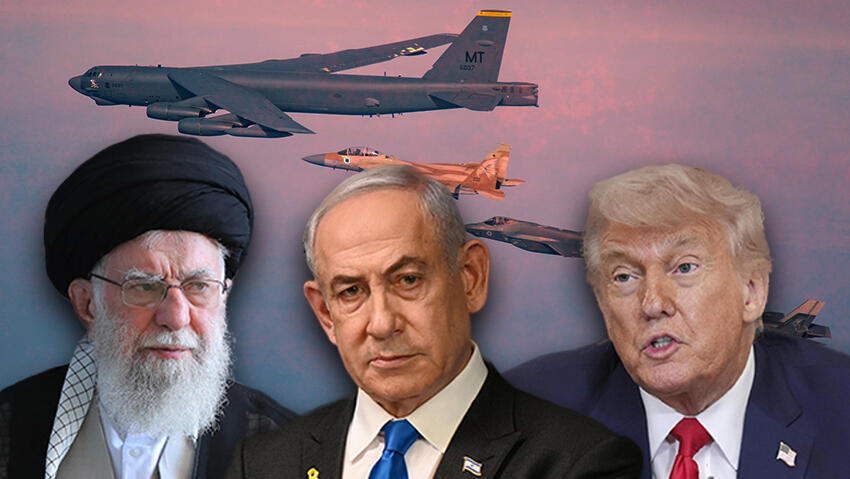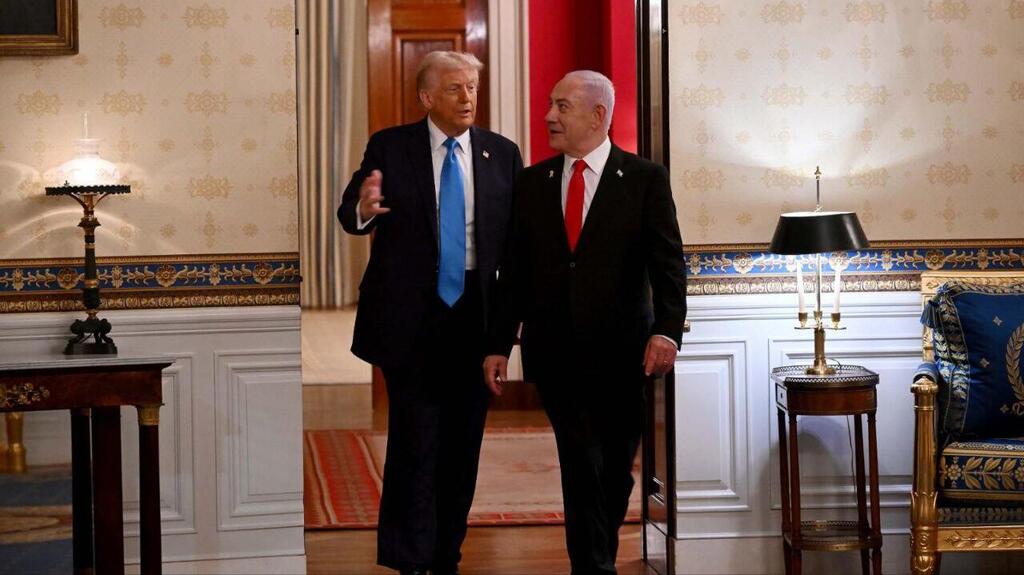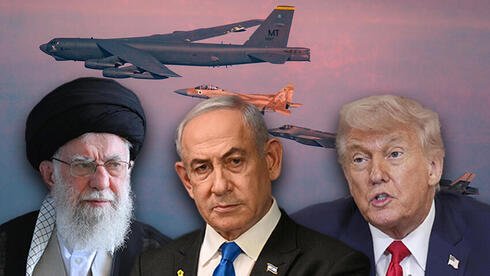At the end of May, U.S. intelligence agencies tracking Israel’s military activity and internal political discussions reached a striking conclusion: Prime Minister Benjamin Netanyahu was planning an imminent attack on Iran’s nuclear program—with or without U.S. assistance, The New York Times reported late Tuesday night.
Netanyahu has long warned about Iran and pressed for an attack on its nuclear facilities for over a decade, but he hesitated when recent U.S. presidents made clear they would not join him, according to the Times. However, this time American intelligence judged that Netanyahu might “go it alone” on a significant strike against Iran’s nuclear project.
2 View gallery


(Photo: Haim Zach/GPO; Evelyn Hockstein/Reuters, Iranian Leader’s Press Office – Handout/Getty Images, IDF Spokesperson)
President Donald Trump, since returning to the White House, has pursued a diplomatic resolution—possibly involving direct talks with Iran—to avoid military action. This has left him facing difficult choices. Netanyahu first sought U.S. approval for a strike in April. Last month, the two leaders held a tense phone call during which Trump warned Netanyahu against a unilateral Israeli attack.
But in recent weeks discussions reported by the Times with “key figures involved in government deliberations and thinking” made it increasingly clear to the Trump administration that this time U.S. pressure might not deter Netanyahu. Meanwhile, Trump grew frustrated with Tehran over the slow pace of nuclear talks, concluding they “weren’t getting anywhere.”
Contrary to Israeli claims, Washington assessed Iran was not close to obtaining a nuclear weapon, and no new intelligence suggested Tehran was about to build one. Still, Trump’s advisers believed Netanyahu could not be stopped and began exploring options: stand aside, or join Israel in an attack—possibly even helping to topple the Iranian regime.
2 View gallery


Prime Minister Benjamin Netanyahu meets with US President Donald Trump
(Photo: Avi Ohayon/GPO)
Ultimately, Trump chose a middle path. He offered Israel intelligence support for planning the strike, while continuing diplomatic pressure on Iran to reach an agreement, threatening unspecified consequences if it refused. Initially distancing from the operation, U.S. support grew more public as details of the Israeli strike emerged. According to reports in Israel, Washington is expected to join future attacks on Iran and has deployed fighter jets to the Middle East.
The Times said interviews with over 20 officials in the U.S., Israel and Gulf states show Trump agonized for months over how to restrain Netanyahu’s military ambitions while navigating internal administration divisions—during a period when he was surrounded by newly appointed advisers loyal but inexperienced.
On June 8, Trump met senior advisers at Camp David to discuss escalation between Israel and Iran and regional developments. Two sources said CIA director John Ratcliffe delivered a blunt assessment that Israel would strike Iran “in the near term”—with or without U.S. help.
Top advisers had long prepared for this moment. Joint Chiefs Chair Gen. Dan Caine shared maps with Trump, and he and Ratcliffe spent two-and-a-half hours reviewing the intelligence. Vice President J.D. Vance and Secretary of State Marco Rubio—also Trump’s national security adviser—prepared a menu of options to enable swift decisions. National Intelligence Director Tulsi Gabbard, a known opponent of a strike, was not present.
The CIA intensified its intelligence gathering in the two weeks before that meeting; advisers prepared contingency plans. The next day, Trump spoke to Netanyahu, and according to three sources, the prime minister was unequivocal: the operation was moving forward.
Netanyahu laid out detailed operational plans and claimed Israeli forces were already on Iranian soil. Trump was impressed by “the sophistication of the Israeli military planning,” but did not commit to assist. After the call he told advisers: “I think we might have to help him.”
Still, Trump was not fully decided; he continued consulting and insisted he would set conditions, not Netanyahu. He trusted his negotiating skills. Gradually, he grew convinced that Iran was stalling talks. He was consistent in opposing an Iranian nuclear bomb and said publicly that “there must be no nuclear Iran.” According to the Times, he told advisers that Netanyahu will do what is necessary to defend his country.
Trump continued trying diplomatic channels. He appointed Steve Witkoff as envoy to manage talks with Iran. Mediated via Oman, Witkoff and Iranian foreign minister Abbas Araqchi held multiple rounds that so far yielded little.
According to the Times, on Netanyahu’s first February White House visit he briefed Trump on Iran and claimed Tehran was close to building a bomb. Trump recognized he was entering a political minefield: his party was divided between hawks supporting Israel, like former National Security Adviser Mike Waltz, and non-interventionists like the vice president.
However, unlike during his previous term, Trump was surrounded by advisers ready to support his instincts. CIA chief Ratcliffe presented data without dictating policy. Gabbard, despite her opposition, did not attempt to pressure Trump on whether to join Israel militarily.
In March, Trump even wrote to Supreme Leader Ayatollah Ali Khamenei saying, “I don’t want war. I don’t want to blow you off the map; I want a deal.” But he came to believe that credible military options would strengthen his negotiating position.
Even before Trump returned to office in January, the Pentagon had plans to attack Iran’s nuclear facilities. Once sworn in, he authorized CENTCOM to coordinate with Israel on refining those plans. By mid-February, three main options had been developed:
U.S. support of Israeli air-to-air refueling and intelligence.
A joint U.S.–Israel strike operation.
A U.S.-led strike operation—with Israel in support, featuring heavy bombers, carrier-based jets and submarine-launched cruise missiles.
A fourth, more aggressive option—an extensive U.S. attack combined with Israeli commando action and U.S. air cover—was quickly set aside.
Meanwhile, Witkoff’s talks with Tehran continued, but Israel’s patience wore thin. In April, Netanyahu made a rapid visit to the White House requesting bunker-busting bombs for hitting Iran’s underground Fordo facility. Trump, still inclined toward diplomacy, was unconvinced. His advisers then applied concentrated pressure on Israel to postpone attacks. The message to Netanyahu was: “You can’t just operate alone. The consequences for us are too severe.” The talks were tense, but the administration believed the message was received.
Trump worried Israel might launch a unilateral attack or derail the talks, and feared a failed strike on Iranian nuclear infrastructure. U.S. intelligence had detailed Israeli strike preparations; briefings to Trump set the stage for the late-May tense call during which he vented frustration to Netanyahu.
Vance concluded that confrontation with Iran was inevitable. Sources said that while he was open to supporting a limited Israeli strike, in the weeks leading up to potential action he became more concerned about a prolonged war. He saw regime change as a dangerous escalation that could get out of control.
Vance focused on limiting U.S. involvement and worked with Rubio, White House Chief of Staff Susie Wiles and others to develop plans to protect U.S. assets in the region. In early June, Witkoff told associates a U.S.–Iran deal was close, but on June 4 Khamenei rejected the proposal.
That same day, conservative Fox News host Mark Levin met with Trump and advisers near the West Wing dining room. Levin, an influential voice, greatly affected Trump’s views on Iran. After meeting him, Trump told aides he still wanted to give diplomacy a chance. That led to the Camp David meeting.
One U.S. source involved in negotiations with Iran said Trump maintained public support for diplomacy and did not intend to mislead Iran on timing of the Israeli strike. The resulting Israeli operational deception, which kept Iranian forces unalerted during the strike night, was seen as a “welcome bonus.”
Privately, Trump expressed doubt about Netanyahu’s decision: “I’m not sure about Bibi,” he told a confidant, acknowledging he had warned him about the consequences. On the Thursday–Friday night of the initial strike wave, Trump joined his national security team in the Situation Room, saying he left “all options open.” That same morning he told aides he still hoped to reach a deal with Iran.
The White House’s first public response came from Secretary of State Rubio, who distanced the U.S. from the Israeli operation—and notably omitted any mention of U.S. commitment to its ally. But as the night wore on and Israeli success became clear, Trump began softening his public posture.
When Fox News aired in-depth coverage praising Israel’s “military genius,” Trump started hinting he deserved credit behind the scenes. He suggested it was due in part to his involvement and privately told aides he was leaning toward a broader escalation, including supplying bunker‑buster bombs to Israel.
As of Monday, he left the door open for Witkoff—or possibly Vance—to meet Iranian officials in attempts to reach a deal. But his sudden early departure from the G7 summit in Canada and urgent return to Washington signaled that diplomatic resolution may no longer be a priority.
Trump has so far tried to avoid war in the Middle East as he promised during his campaign—but today he seems aligned with Israel’s narrative that Iran is close to a bomb. “I don’t care,” he said regarding criticism of Iran’s nuclear progress.




